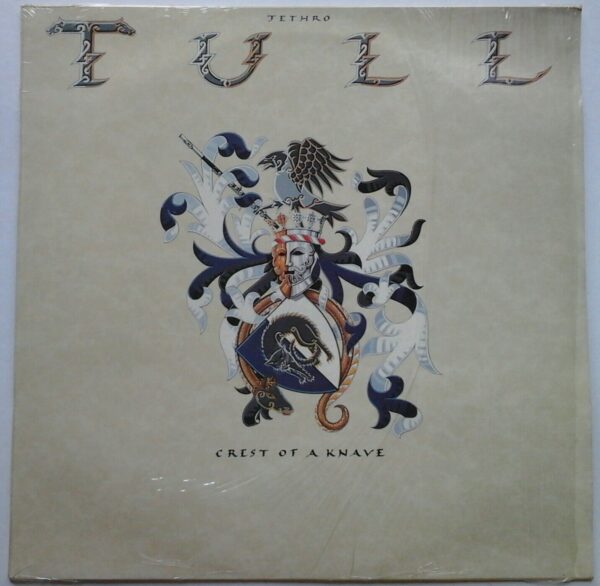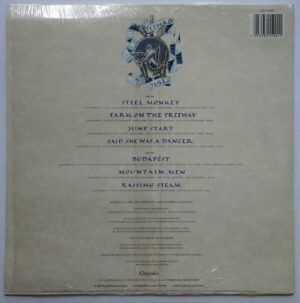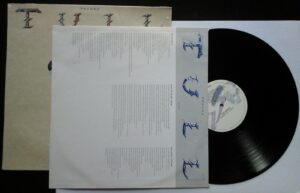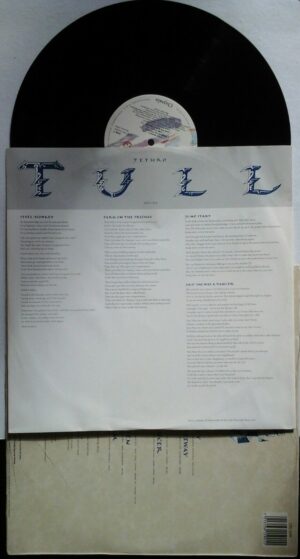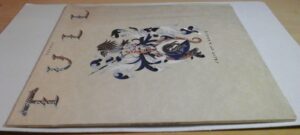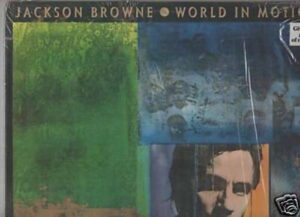Descrizione
PREMESSA: LA SUPERIORITA’ DELLA MUSICA SU VINILE E’ ANCOR OGGI SANCITA, NOTORIA ED EVIDENTE. NON TANTO DA UN PUNTO DI VISTA DI RESA, QUALITA’ E PULIZIA DEL SUONO, TANTOMENO DA QUELLO DEL RIMPIANTO RETROSPETTIVO E NOSTALGICO , MA SOPRATTUTTO DA QUELLO PIU’ PALPABILE ED INOPPUGNABILE DELL’ ESSENZA, DELL’ ANIMA E DELLA SUBLIMAZIONE CREATIVA. IL DISCO IN VINILE HA PULSAZIONE ARTISTICA, PASSIONE ARMONICA E SPLENDORE GRAFICO , E’ PIACEVOLE DA OSSERVARE E DA TENERE IN MANO, RISPLENDE, PROFUMA E VIBRA DI VITA, DI EMOZIONE E DI SENSIBILITA’. E’ TUTTO QUELLO CHE NON E’ E NON POTRA’ MAI ESSERE IL CD, CHE AL CONTRARIO E’ SOLO UN OGGETTO MERAMENTE COMMERCIALE, POVERO, ARIDO, CINICO, STERILE ED ORWELLIANO, UNA DEGENERAZIONE INDUSTRIALE SCHIZOFRENICA E NECROFILA, LA DESOLANTE SOLUZIONE FINALE DELL’ AVIDITA’ DEL MERCATO E DELL’ ARROGANZA DEI DISCOGRAFICI .
JETHRO TULL
crest of a knave
Disco LP 33 giri , Chrysalis / BMH Ariola , CDL 1590 , 1987 , Italia
ECCELLENTI
CONDIZIONI, vinyl ex++/NM , cover ex++/NM, shrink although open
Crest of a Knave è un album della band progressive rock inglese Jethro Tull, pubblicato nel 1987. |
|||||||
Crest of a Knave è considerato in un certo senso l’album della rinascita del gruppo. In effetti gli anni ottanta avevano segnato una sorta di declino e in seguito a Under Wraps sembrava che la band dovesse sciogliersi. Ma dopo 3 anni dall’uscita del precedente album Ian Anderson
riesce a sfornare finalmente un nuovo disco che mette d’accordo tutti i
fans, cosa che non succedeva da ormai una decina d’anni circa. Crest of a Knave non è un album dominato dall’elettronica come lo erano i precedenti. Tornano infatti prepotentemente il flauto traverso e la chitarra elettrica. In seguito all’abbandono di Peter-John Vettese sarà lo stesso Anderson a ricoprire il ruolo di tastierista.
Il risultato fu un successo nel vero senso del termine tanto da
restituire fama e lustro alla band. Addirittura il disco vinse il Grammy Award per il miglior prodotto hard rock/heavy metal dell’anno, nel 1989.
Questo evento creò una certa confusione dal momento che nessuno
considerava (giustamente) i Jethro Tull come un gruppo heavy metal tanto
che la Chrysalis
consigliò alla band di non presentarsi nemmeno alla consegna dei premi
dato che gli altri concorrenti in corsa per il premio erano i molto più
quotati Metallica, Alice Cooper e AC/DC. In particolare i Metallica, con l’album …And Justice for All
erano più che favoriti. All’annuncio della vittoria dei Jethro Tull i
fans dei Metallica si scatenarono in fischi e urla di disapprovazione
tanto da far nascere una sorta di rivalità (anche se il termine è forse
eccessivo) fra i sostenitori delle due band, o quantomeno fra i più
sfegatati. In seguito a questo fatto Anderson e soci fecero pubblicare
su una rivista musicale britannica la frase: “Il flauto è uno strumento heavy metal!”.
Il disco contiene canzoni di ottimo livello, in particolare Budapest, un gioiellino riproposto molto spesso dal vivo, nonché la canzone preferita in assoluto dallo stesso Ian Anderson come egli stesso ha dichiarato in un’intervista.
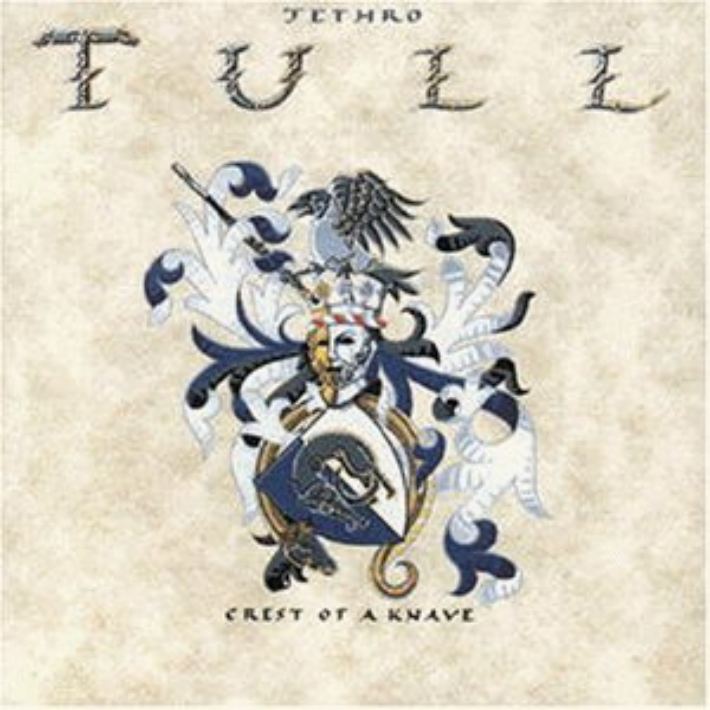
Crest of a Knave is the sixteenth studio album by British rock band Jethro Tull, released in 1987.
The album relied more heavily on Martin Barre‘s electric guitar than the band had since the 1970s. However, several tracks still featured drum machine instead of a live drummer. Keyboardist Peter-John Vettese was now absent and it was Ian Anderson who contributed the synth programming. The album sleeve only lists Ian Anderson, Martin Barre and Dave Pegg as official band members. The cover was designed by heraldic artist Andrew Stewart Jamieson.
The album was a critical and commercial success. It went on to win the 1989 Grammy Award for Best Hard Rock/Metal Performance Vocal or Instrumental, beating the heavily favoured …And Justice for All) and critics’ choice Nothing’s Shocking.
The award was highly controversial as many did not consider the album
or even the band to be hard rock or heavy metal. Under advisement from
their manager, no one from the band turned up to the award ceremony, as
they were told that they had no chance of winning. In response to the
controversy, the band’s record label Chrysalis took out an advert in a British music periodical with the line, “The flute is a heavy, metal instrument!” In 2007, the win was named one of the 10 biggest upsets in Grammy history by Entertainment Weekly.
The style of Crest has been compared to that of Dire Straits,
in part because Anderson no longer had the vocal range he once
possessed (the result of recent throat surgery). Tull’s frank treatment
of sexuality was unabated, however. The album contains the popular live
song “Budapest”, which depicts a backstage scene with a shy local female
stagehand.
Catalogo: CDL1590
Matrici : PA SPIRY CDL 1590 A2S 1 A 3 / AP SPIRY CDL 1590 B1S 1 A 5
- Supporto:vinile 33 giri
- Tipo audio: stereo
- Dimensioni: 30 cm.
- Facciate: 2
- Lyrics inner sleeve
Tracce
All tracks by Ian Anderson
- “Steel Monkey” – 3:35
- “Farm On The Freeway” – 6:28
- “Jump Start” – 4:51
- “Said She Was A Dancer” – 3:39
- “Budapest” – 10:01
- “Mountain Men” – 6:20
- “Raising Steam” – 4:05
 |
|
Players |
|
 |
|
Steel Monkey
L’espressione Steel Monkey (“scimmia d’acciaio”) è usata nello slang
inglese per indicare quegli operai il cui compito è costruire quelle
strutture di acciaio assemblando pezzi di quel materiale o prefabbricati
che costituiranno poi gli scheletri di grossi edifici e grattacieli.
Nel testo viene messo in rilievo il lavoro di questi operai e la canzone
contiene implicitamente una critica contro l’eccessivo sviluppo di
città, aree industriali e rurali, il cui simbolo è la continua nascita
di grattacieli.
Farm on the Freeway
Il concetto dell’avanzare del progresso e della crescita delle
infrastrutture in aree urbane e rurali fa da tema anche per la seconda
canzone dell’album in cui vengono illustrati certi suoi lati negativi.
Jump Start
Nella terza canzone dell’album Anderson tocca una tematica comune
dell’epoca, tuttora attuale: l’alienazione. Nella moderna società
occidentale, dove regna l’individualismo e le comunità locali (dove
tutti si conoscono) tendono a disintegrarsi, le persone si sentono
sempre più staccate l’una all’altra.
Said She Was a Dancer
Dopo tre canzoni in stile hard rock Said She Was a Dancer
ha un ritmo più “tranquillo”. Il testo riguarda le illusioni che le
persone hanno (o si fanno) su se stesse e sugli altri, ma anche sui
sentimenti, desideri e sogni. Nella fattispecie viene descritto
l’incontro fra due persone provenienti da due zone diverse, separate
dalla Cortina di Ferro (“eastern steel – western gold“), mentre ciascuno dei due si fa un’immagine personalizzata sull’altro.
Budapest
Si tratta di uno dei pezzi più proposti dal vivo negli ultimi anni,
probabilmente anche per il fatto che la canzone è la preferita da Ian
Anderson, per sua stessa ammissione. Dalla durata piuttosto
considerevole (10 minuti circa) essa è stata ispirata allo stesso
Anderson in occasione di un concerto realizzato appunto nella capitale ungherese Budapest nell’estate del 1986.
Il giorno successivo, durante la colazione, Anderson notò una cameriera
dal fisico piuttosto atletico e particolarmente alta, figura su cui si
incentra l’intero brano.
Mountain Men
Il pezzo si riferisce alla Scozia, terra natale di Ian Anderson. La piper citata più volte nel testo è la cornamusa,
strumento tipico scozzese. La canzone contiene anche un riferimento
alle varie guerre combattute dai soldati britannici nel corso della
storia e la nostalgia che questi soldati provavano e provano tuttora per
la loro terra, concetto già espresso in passato nell’album War Child del 1974.
Raising Steam
Per il suo immaginario, questo pezzo evoca associazione di idee con quelle canzoni folk on the road,
in cui viene espresso il sentimento di sentirsi rinchiusi nel proprio
ambiente e la conseguente urgenza di dover fuggire, liberarsi da esso.
Il treno è il simbolo di questa fuga (roll those tracks out oppure You got your locomotive sitting on your track).
Ian Anderson and company seemed to make a conscious effort to update Jethro Tull‘s
sound on this record. And, to the amazement (and distress) of many, it
was voted the Grammy Award for Best Hard Rock/Heavy Metal Performance.
Truth is, it isn’t a bad album, with an opening track that qualifies as
hard rock and pretty much shouts its credentials out in Martin Barre‘s
screaming lead guitar line, present throughout. “Jump Start” and
“Raising Steam” also rock hard, and no one can complain of too much on
this record being soft, with “Budapest” and “Said She Was a Dancer,” Anderson‘s two aging rock-star’s-eye-view accounts of meeting women from around the world. The antiwar song “Mountain Men” is classic Tull-styled
electric folk, all screaming electric guitars at a pretty high volume
by its end. Overall, this is a fairly successful album and arguably
their best since 1978, even if it does seem a little insignificant in
relation to, say, Thick As a Brick. By this time Tull was effectively a core trio of Anderson, Barre, and bassist Dave Pegg, augmented by whatever musicians (drummers Gerry Conway and Doane Perry, Fairport Convention keyboard player Martin Allcock, and violinist Ric Sanders)
that they needed to fill out their sound. The result is a very
lean-sounding group and a record probably as deserving of a Grammy as
any other album of its year — in the cosmic scheme, it sort of made up
for Tull‘s not winning one for Thick As a Brick or Aqualung, or for Dave Pegg‘s former band Fairport Convention never winning.

In 1987, the CD was
still catching on as a new format and most record shops were still
firmly dedicated to stocking and selling LPs. That autumn, I would head
down after school to a record shop and enthusiastically rummage through
the bins. What attracted my particular attention were new albums by
three of my favorite bands at the time: Big Generator by Yes, Hold Your Fire by Rush, and Crest of a Knave by Jethro Tull.
I remember picking all three up at around the same time, each with a
simple iconography strewn across the gloriously huge space offered to
the cover for the LP format. As it would turn out, sadly, all three
albums would be disappointments of varying degrees. In the case of the
latter two, I had heard rumors from other fans at my school
word-of-mouth (remember, this was long before the days of the WWW and
fan forums) that these albums would be a return to ‘classic form,’ away
from the pop and synth-driven tendencies that had spread through their
recent albums. This, of course, turned out to be crap.
As a teenage
boy whose main previous exposure to Jethro Tull was their classic stuff,
I wasn’t quite prepared for the mostly laid back offerings that greeted
me here. Where were the contrapuntal bass runs? The Hammond organ?
Did I pick up a Dire Straits album by mistake (not that there’s anything wrong with that)?
Returning to Crest of a Knave
all these years later, I am quickly reminded about what really bugged
me about the album then. The worst things remain the thin, late 80s
production and the icky drum programming, neither of which have worn
well. The album’s most popular track, the generic “Steel Monkey,” would
have generated a lot more heat with a real drummer, but even when there
is a real drummer present, they seem to be there strictly for the
paycheck.
That being said, as a mellow grown-up I find that myself
enjoying this album much, much more. From a lyric-writing standpoint,
Ian Anderson was stronger than ever. With his inimitable turn of phrase
and irony, Anderson weaves vivid pictures with his words, particularly
on the placid offerings that are, yes, a dead ringer for Mark Knopfler’s
band (“Said She Was a Dancer,” “Budapest,” “Mountain Men”) but also on
the grittier numbers (“Steel Monkey,” “Jump Start”), all of which tended
to go over my head back then.
Like many other prog albums first explored as a teenager and exasperatingly filed away, Crest of a Knave
is one with which I find myself fully reconciled. Though I wouldn’t
call it a classic by any stretch of the imagination, it is a decent
effort worthy of some respect.

Nel 1987, il ritorno della voce di Anderson con Crest of a Knave, un album che mette d’accordo critica e fan, dove vi è un uso molto più forte della chitarra elettrica di Barre.
Comunque, si vedono anche ombre delle passate sperimentazioni
elettroniche, accompagnate da un forte rientro del flauto traverso,
messo un po’ da parte nei loro lavori precedenti.
Con Crest of a Knave, i Jethro Tull vincono un Grammy per il miglior disco hard rock/heavy metal nel 1989. Seguendo il consiglio del loro manager, che assicurava loro che non avrebbero mai vinto contro i più quotati Metallica, AC/DC ad Alice Cooper,
nessun membro della band si presenta alla consegna del premio: tra
l’altro, se erano pochi quelli che li consideravano una band hard rock, ancor meno lo erano coloro che li definivano heavy metal.
In risposta alle critiche ricevute per il premio, la band pubblica una
pubblicità su un periodico inglese che raffigurava un flauto traverso e
la scritta:
| « Il flauto è uno strumento heavy metal. » |
Nel 2007 Entertainment Weekly ha definito quella vittoria una delle più sconvolgenti della storia dei Grammy. Nel 1992, quando i Metallica vinsero finalmente il Grammy nella categoria, il batterista Lars Ulrich dichiarò:
| « La prima cosa da fare è ringraziare i Jethro Tull per non aver pubblicato un album quest’anno. » |
Lo stile dell’album è stato paragonato a quello dei Dire Straits in parte anche perché Ian Anderson sembrava non avere più la portata vocale di un tempo.

After
four years spent by Jethro Tull futilely advancing into electronic
territory, and especially after the synth-laden mess that was Under Wraps, it was easy to overvalue the band’s supposed return to form, Crest Of A Knave.
The album was instantly lapped up by critics and especially by fans,
happy that Anderson finally decided to return to familiar ground. And
yet, soon after the band was awarded the infamous 1989 Grammy for best
hard rock performance (one that arguably should have belonged to
Metallica), it seems that the general public realized that Crest Of A Knave contained rather little to be excited about, and was really a rather average album for Ian Anderson and friends.
The first thing one realizes when listening to Crest Of A Knave
is Anderson’s weakened voice: prior to recording the album, the singer
experienced throat surgery. The minstrel’s voice on this album was
often likened to that of The Dire Strait’s Mark Knopfler, a comparison
that is very valid. Unfortunately, Anderson’s vocal range suffered
greatly during the operation, and so the melodies stay confined to a
very small register, and his
voice has a harsh, raspy quality to it. Consequentially, the music
never really is given the opportunity to become as interesting as on
past albums such as Too Old To Rock ‘n’ Roll: Too Young To Die! or Stand Up.
The next thing that one realizes is that most of Crest Of A Knave
is really quite boring. The drum machines featured on some of the
songs are incapable of replicating the attention-grabbing theatrics of
Barrimore Barlow who, despite his love for flashy drumming always knew
when to restrain himself. Unfortunately, he human drummers that are
present on the majority of the tracks rarely are able to do any better
than the aforementioned machines. The melodies are all sterile, and
seem like the kind of thing that would be left over from one of The Dire
Straits’ weaker albums, and the majority of the songs spend half of
their runtimes meandering aimlessly.
That’s not to say anything on Crest Of A Knave, aside from the atrocious Steel Monkey,
is offensively bad, but almost equally little is particularly
captivating. Indeed, only two songs on the album are worth the full
price of admission: Said She Was A Dancer and Budapest.
The former is a tender, particularly Straits-esque tune, and is oddly
enthralling, while the latter is an adventurous, ten minute-long epic. Budapest,
like a majority of the band’s other epics, does end up occasionally
drifting off into aimless drivel, but such moments are rare and the song
really does have more interesting melodies than all of the other tracks
combined.
Truth be told, Budapest and only Budapest makes Crest Of A Knave worthy of one’s attention. Aside from this song and, to a far lesser extent, Said She Was A Dancer, the majority of the album is painfully average and, ultimately harmless. Still, Crest Of A Knave fares far better than it’s successor, Rock Island, which offered very little (by this I mean virtually nothing) of interest.
|
||||||||||||||||||||||||||
|
Già L’anno Modalità Proprio Con Alla |
||||||||||||||||||||||||||


